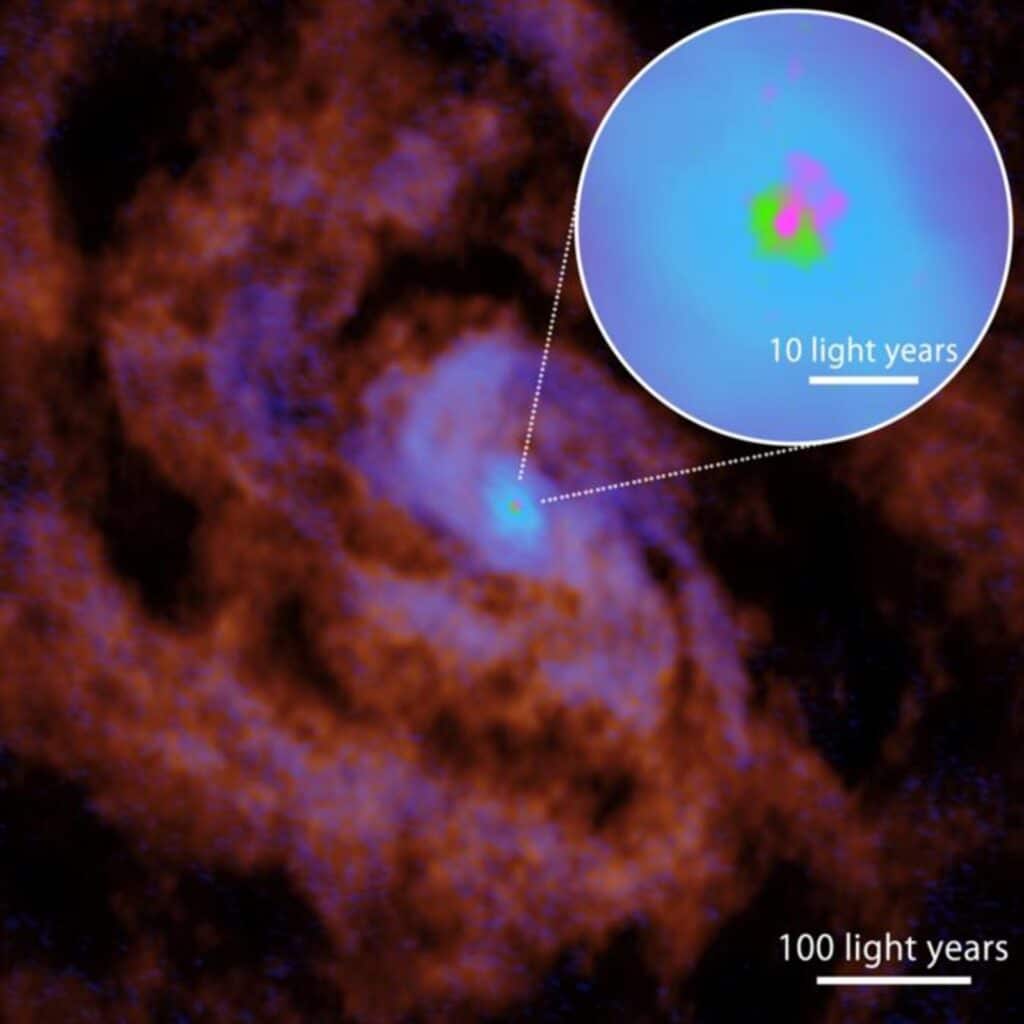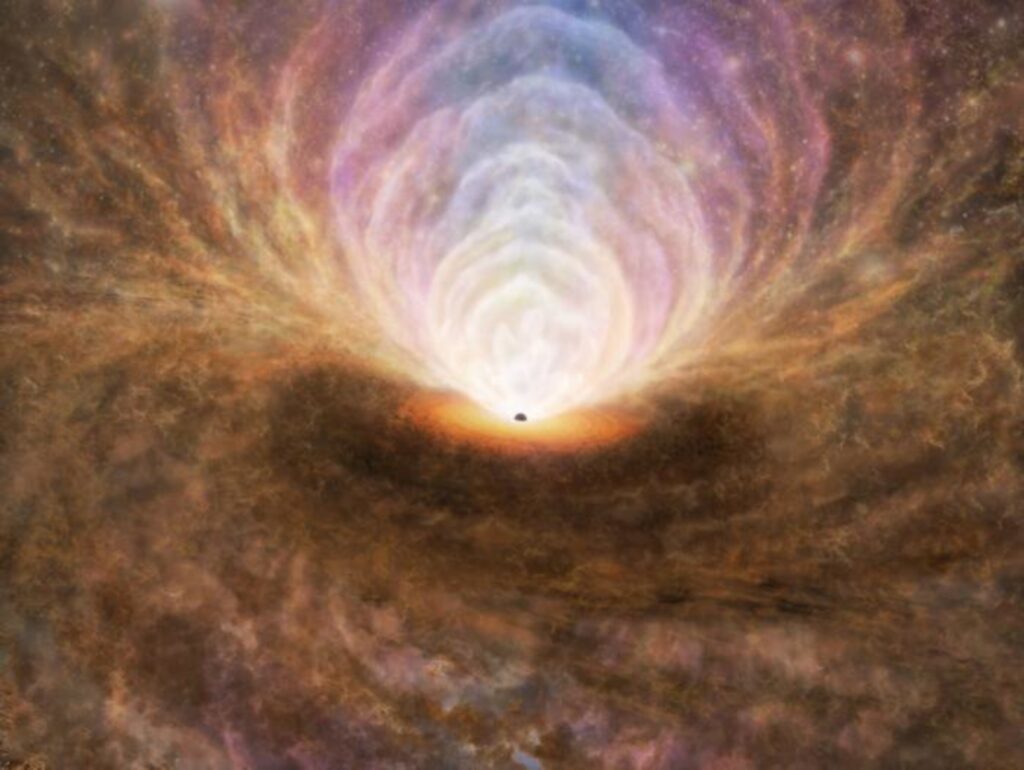A team of international astronomers has made a groundbreaking observation of the tumultuous environment surrounding a supermassive black hole in the Circinus Galaxy, which lies close to our own Milky Way. The group was able to view the area around the black hole with a clarity measured at around one light year — a remarkable achievement in celestial observation.
This observation was made possible thanks to the Atacama Large Millimeter/Submillimeter Array (ALMA) astronomical observatory in Chile.
This milestone marks the world’s first quantitative measurement at such a fine scale of gas flows and their structures around a nearby supermassive black hole, encompassing all phases of gases, including plasma, atomic, and molecular. The team’s high-resolution capabilities allowed them to capture the accretion flow heading toward the supermassive black hole and reveal that this flow is generated by a physical mechanism known as “gravitational instability.”
Accretion flow is like a cosmic waterfall: it’s the stream of gas, dust, and other space debris that gets pulled in toward a supermassive black hole. As this material spirals closer, it speeds up and heats up due to the black hole’s powerful gravity. Just like water spirals down a drain, this space material spirals inward until some of it falls into the black hole, and some might get shot back out into space.
Astronomers discovered that a significant portion of this accretion flow does not contribute to the growth of the black hole. Instead, most of the gas is expelled from the vicinity of the black hole as atomic or molecular outflows, only to return to the gas disk, participating once again in an accretion flow toward the black hole, akin to how water recycles in a fountain. These findings represent a crucial step toward gaining a deeper understanding of the growth mechanisms of supermassive black holes.
Understanding Supermassive Black Holes
Supermassive black holes, which possess masses exceeding a million times that of the sun, are found at the centers of many galaxies. However, the mechanisms responsible for their formation have puzzled astronomers for years. One proposed mechanism suggests that gas accumulates onto the black hole as it gravitates toward the center of its host galaxy.

As gas approaches the supermassive black hole, the intense gravitational pull of the black hole causes the gas to accelerate. This acceleration leads to an increase in friction among gas particles, resulting in the gas heating up to temperatures as high as several million degrees and emitting intense light. This phenomenon is known as an active galactic nucleus (AGN), and its brightness can sometimes exceed the combined light emitted by all the stars in the galaxy. Importantly, a portion of the gas that falls toward the black hole (accretion flow) is believed to be ejected due to the immense energy generated by the active galactic nucleus, creating outflows.
Prior research had provided detailed insights into gas accretion mechanisms ranging from a scale of 100,000 light-years down to a few hundred light-years at the galactic center. The accretion of gas occurs just a few dozen light-years from the galactic center, a spatial scale that had impeded a deeper understanding of the accretion process. To quantitatively comprehend the growth of black holes, it is necessary to measure the rate of accretion (how much gas is flowing in) and determine the quantities and types of gases (plasma, atomic gas, molecular gas) expelled as outflows on this small scale. Unfortunately, observational understanding had not made significant progress until now.
“Observations of multiphase gases can provide a more comprehensive and thorough understanding of the distribution and dynamics of matter around a black hole and our observation marks the highest resolution ever achieved for multiphase gas observations in an active galactic nucleus,” says study author Takuma Izumi, an assistant professor at the National Astronomical Observatory of Japan, in a media release.
High-Resolution Breakthrough
Izumi and his colleagues managed to capture, for the first time, the accretion flow heading toward the supermassive black hole within the high-density gas disk that extends over several light-years from the galactic center. Identifying this accretion flow had long been a challenge due to the small scale of the region and the complex motions of gas near the galactic center.
Researchers identified the location where foreground molecular gas was absorbing the light from the intensely shining active galactic nucleus in the background. Detailed analysis showed that this absorbing material was moving away from Earth. As this absorbing material consistently lay between the active galactic nucleus and Earth, it indicated the successful capture of the accretion flow heading toward the active galactic nucleus.
Revealing the Accretion Mechanism
The study also uncovered the physical mechanism responsible for inducing gas accretion. The observed gas disk exhibited an extraordinarily strong gravitational force that could not be counteracted by the pressure calculated from the gas disk’s motion. In such cases, the gas disk collapses under its own weight, forming complex structures and losing its ability to maintain stable motion at the galactic center. Consequently, the gas rapidly descends toward the central black hole, a phenomenon known as “gravitational instability” at the heart of the galaxy.
Furthermore, the study enhanced the quantitative understanding of gas flows surrounding the active galactic nucleus. By considering the density of the observed gas and the velocity of the accretion flow, the researchers calculated the rate at which gas is supplied to the black hole. Surprisingly, this rate was found to be 30 times greater than what is needed to sustain the active galactic nucleus. In other words, most of the accretion flow at the 1-light-year scale around the galactic center was not contributing to the black hole’s growth.
Where Does the Surplus Gas Go?
So, what happened to the excess gas? High-sensitivity observations of all phase gases (medium-density molecular, atomic, and plasma) with ALMA detected outflows from the active galactic nucleus. Quantitative analysis revealed that the majority of the gas flowing toward the black hole was expelled as atomic or molecular outflows. Due to their slow velocities, these outflows could not escape the gravitational pull of the black hole and eventually returned to the gas disk. There, they were recycled into an accretion flow toward the black hole, completing a fascinating gas recycling process at the galactic center.
“Detecting accretion flows and outflows in a region just a few light-years around the actively growing supermassive black hole, particularly in a multiphase gas, and even deciphering the accretion mechanism itself, are monumental achievements in the quest to reveal more about supermassive black holes,” explains Izumi. “To gain a comprehensive understanding of the growth of supermassive black holes in cosmic history, it is essential to investigate various types of supermassive black holes that are located farther away from us. This requires high-resolution and high-sensitivity observations, and we have high expectations for the continued use of ALMA, as well as for upcoming large radio interferometers in the next generation.”
The study is published in the journal Science.












